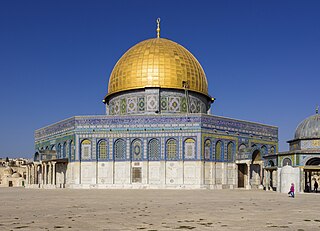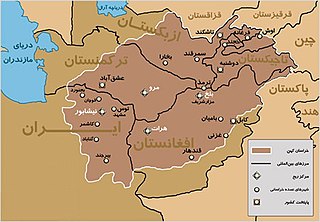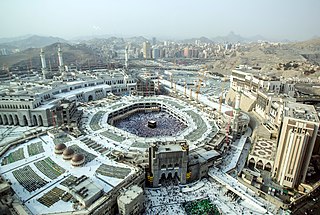Related Research Articles

The Reconquista is the historical term used to describe the military campaigns that Christian kingdoms waged from the 8th century until 1492, in order to retake the Iberian territories which were lost due to the Umayyad conquest of Hispania. The beginning of the Reconquista is traditionally dated to the Battle of Covadonga, in which an Asturian army achieved the first Christian victory over the Arab-Berber forces of the Umayyad Caliphate since the beginning of the military invasion. Its culmination came in 1492 with the fall of the Nasrid kingdom of Granada to the united Spanish Crown of Ferdinand II of Aragon and Isabella I of Castile.

The culture of Egypt has thousands of years of recorded history. Ancient Egypt was among the earliest civilizations in the world. For millennia, Egypt developed strikingly unique, complex and stable cultures that influenced other cultures of Europe, Africa and the Middle East.

The Dome of the Rock is an Islamic shrine at the center of the Al-Aqsa Mosque compound on the Temple Mount in the Old City of Jerusalem, a site also known to Muslims as the Haram al-Sharif or Al-Aqsa. Its initial construction was undertaken by the Umayyad Caliphate on the orders of Abd al-Malik during the Second Fitna in 691–692 CE, and it has since been situated on top of the site of the Second Jewish Temple, which was destroyed by the Romans in 70 CE. The original dome collapsed in 1015 and was rebuilt in 1022–23. The Dome of the Rock is the world's oldest surviving work of Islamic architecture.

ʿUmar ibn al-Khaṭṭāb was the second Rashidun caliph, ruling from August 634 until his assassination in 644. He succeeded Abu Bakr as the second caliph of the Rashidun Caliphate on 23 August 634. Umar was a senior companion and father-in-law of the Islamic prophet Muhammad. He was also an expert Muslim jurist known for his pious and just nature, which earned him the epithet Al-Fārūq.

The terms Muslim world and Islamic world commonly refer to the Islamic community, which is also known as the Ummah. This consists of all those who adhere to the religious beliefs and laws of Islam or to societies in which Islam is practiced. In a modern geopolitical sense, these terms refer to countries in which Islam is widespread, although there are no agreed criteria for inclusion. The term Muslim-majority countries is an alternative often used for the latter sense.
Islamic studies refers to the academic study of Islam, and generally to academic multidisciplinary "studies" programs—programs similar to others that focus on the history, texts and theologies of other religious traditions, such as Eastern Christian Studies or Jewish Studies but also fields such as —where scholars from diverse disciplines participate and exchange ideas pertaining to the particular field of study.

Al-Andalus was the Muslim-ruled area of the Iberian Peninsula. The term is used by modern historians for the former Islamic states in modern Spain and Portugal. At its greatest geographical extent, it occupied most of the peninsula and a part of present-day southern France, Septimania. For nearly 100 years, from the 9th century to the 10th, al-Andalus extended its presence from Fraxinetum into the Alps with a series of organized raids. The name describes the different Muslim states that controlled these territories at various times between 711 and 1492. These boundaries changed constantly as the Christian Reconquista progressed, eventually shrinking to the south and finally to the Emirate of Granada.

The taifas were the independent Muslim principalities and kingdoms of the Iberian Peninsula, referred to by Muslims as al-Andalus, that emerged from the decline and fall of the Umayyad Caliphate of Córdoba between 1009 and 1031. They were a recurring feature of al-Andalus history.

Greater Khorāsān, or Khorāsān, is a historical eastern region in the Iranian Plateau between Western and Central Asia. The name Khorāsān is Persian meaning "where the sun arrives from" or "the Eastern Province". The name was first given to the eastern province of Persia during the Sasanian Empire and was used from the late Middle Ages in distinction to neighbouring Transoxiana. Greater Khorasan is today sometimes used to distinguish the larger historical region from the former Khorasan Province of Iran (1906–2004), which roughly encompassed the western half of the historical Greater Khorasan.

Mudéjar art, also known as Mudéjar style, refers to a type of ornamentation and decoration used in the Iberian Christian kingdoms, primarily between the 13th and 16th centuries. It was applied to Romanesque, Gothic, and Renaissance architectural styles as constructive, ornamental, and decorative motifs derived from those that had been brought to or developed in Al-Andalus. These motifs and techniques were also present in the art and crafts, especially Hispano-Moresque lustreware that was once widely exported across Europe from southern and eastern Spain at the time.
Dawit I was Emperor of Ethiopia from 1382 to 6 October 1413, and a member of the Solomonic dynasty. He was the younger son of Newaya Krestos.
The Islamization of Iran occurred as a result of the Muslim conquest of Persia in 633–654. It was a long process by which Islam, though initially rejected, eventually spread among the population on the Iranian Plateau. Iranian peoples have maintained certain pre-Islamic traditions, including their language and culture, and adapted them with Islamic codes. These two customs and traditions merged as the "Iranian Islamic" identity.
The composite Turko-Persian, Turco-Persian or Turco-Iranian tradition was a distinctive culture that arose in the 9th and 10th centuries in Khorasan and Transoxiana.

The persecution of Zoroastrians has been recorded throughout the history of Zoroastrianism, an Iranian religion. The notably large-scale persecution of Zoroastrians began after the rise of Islam in the 7th century CE; both during and after the conquest of Persia by Arab Muslims, discrimination and harassment against Zoroastrians took place in the form of forced conversions and sparse violence. Muslims who arrived in the region after its annexation by the Rashidun Caliphate are recorded to have destroyed Zoroastrian temples, and Zoroastrians living in areas that had fallen under Muslim control were required to pay a tax known as jizya.
The Great Seljuk Empire, or the Seljuk Empire, was a high medieval, culturally Turco-Persian, Sunni Muslim empire, founded and ruled by the Qïnïq branch of Oghuz Turks. It spanned a total area of 3.9 million square kilometres from Anatolia and the Levant in the west to the Hindu Kush in the east, and from Central Asia in the north to the Persian Gulf in the south.
Sin is an important concept in Islamic ethics that Muslims view as being anything that goes against the commands of God in Islam Allah (God) or breaching the laws and norms laid down by religion. Islam teaches that sin is an act and not a state of being. It is believed that God weighs an individual's good deeds against their sins on the Day of Judgement and punishes those individuals whose evil deeds outweigh their good deeds.
The Nagori is a Muslim community found in the state of Rajasthan in India.

Muslims, Christians, and Jews co-existed for over seven centuries in the Iberian Peninsula during the era of Al-Andalus states. The degree to which the Christians and the Jews were tolerated by their Muslim rulers is a subject widely contested among historians. The history of Al-Andalus indicates that Muslims, Christians, and Jews who lived within Al-Andalus had relatively peaceful relations, with the exception of a few scattered revolts, and times of religious persecution. The great amount of cultural and social interaction that took place between these three distinct social and religious groups led to the creation of a unique and diverse culture that continued to flourish even after the Reconquista.

Masjid al-Haram, also known as the Grand Mosque or the Great Mosque of Mecca, is a mosque enclosing the vicinity of the Kaaba in Mecca, in the Mecca Province of Saudi Arabia. It is a site of pilgrimage in the Hajj, which every Muslim must do at least once in their lives if able, and is also the main phase for the ʿUmrah, the lesser pilgrimage that can be undertaken any time of the year. The rites of both pilgrimages include circumambulating the Kaaba within the mosque. The Great Mosque includes other important significant sites, including the Black Stone, the Zamzam Well, Maqam Ibrahim, and the hills of Safa and Marwa.

Mudéjar refers to the group of Muslims who remained in Iberia in the late medieval period despite the Christian reconquest. It is also a term for Mudejar art, which was much influenced by Islamic art, but produced typically by Christian craftsmen for Christian patrons.
References
- ↑ Barnes, Harry Elmer (1965). An intellectual and cultural history of the Western World . Dover Publications. p. 496. OCLC 390382.
- ↑ Forbes, Robert James (1970). A short history of the art of distillation: from the beginnings up to the death of Cellier Blumenthal. BRILL. p. 42. ISBN 978-90-04-00617-1.